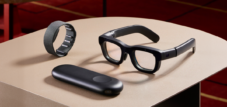Published on: July 13, 2025 / update from: July 13, 2025 - Author: Konrad Wolfenstein

The 'Spotify moment' of the AR industry? Snap Specs-on the way to everyday AR glasses? - Image: Xpert.digital
In 2026, Snap shows the future of AR glasses: It should be easier than Apple Vision Pro, Smarter than Ray-Ban
Snap announces "Specs"-the first AR glasses for consumers
Augmented Reality (AR) stands on the threshold of switching from the developer field of experimentation to the everyday life of the masses. While Apple explores the premium market with its vision and Meta constantly expands its Ray Ban strategy, Snap is a middle ground: lighter than a head-mounted display, more functional than pure camera glasses and clearly at Apple's 3 $ 499 border. The “Specs”, which appeared in 2026, are intended to show that full -fledged AR is possible in an inconspicuous glasses frame.
Suitable for:
From Spectacles to Specs - a decade learning curve
Snap has been experimenting with smart glasses since 2016. The first spectacles generation was essentially sunglasses with a camera-a playful gadget for Snapchat stories. With every further variant, however, the company approached real AR glasses. In 2021, the fourth generation brought transparent waveguide displays and 6-dof tracking for selected creative for the first time. A year later, Spectacles 5 followed, which offered gesture control, hand tracking and 46-degree field of view thanks to dual-snapdragon architecture. But there was a developer kit: chunky, 226 grams heavy and with 45 minutes of battery life-too little for the mass market.
The consumer version is now waiting for its start under the shortened name "Specs". The change of name signals: This time it should not be a tech demo, but a product for everyone. According to its own information, SNAP invested more than three billion dollars and eleven years of development to overcome this hurdle.
Hardware in detail
The heart of the Specs are newly developed waveguide displays that reflect holographic images directly into the visibility area. Project via micro projectors onto liquid-crystal-on-silicone basis; Each wave ladder contains billions of nanostructures that break the light precisely - this creates a clear, colorful picture even when it comes to sunshine. According to early prototypes, the field of vision grows significantly beyond the previous 46 degrees; Internally, values are circulating around 55 to 60 degrees - enough to anchor virtual objects stable in the room, without a feeling of tunnel.
Snapdragon-based dual soc takes on computing work and sensor exception. One chip sits on the left and right in the bracket, which avoids heat hot spots and better distributes the weight. The processors use several cameras for scene recognition, depth mapping and hand tracking. Six microphones provide spatial audio, open speakers create an acoustic "sweet spot" that bothers people as little as possible.
Snappe-owned Vapor chambers cool the SoCs, while optimized acute parts should be at least 45 minutes of continuous operation according to company-related sources-internally, "halfway working day" is the goal. A magnetic power bridge in the case could reload on the go, similar to Metas Ray-Ban-Case. This means that all -day use moves within sight, but remains the most critical point of the roadmap.
Operating concept - hands instead of controller
Specs rely on natural inputs:
- Hand gestures: The glasses recognize finger movements in near field with high precision. A “typing on top” on the thumb and index finger opens the main menu, wiping in the air through cards, a gentle pinch confirmed.
- Blick control: Eye tracking measures where the user looks, Snap OS marks dynamically buttocks.
- Language: The microphone array forwards commands to Snap Ai, optionally offline local or in the cloud.
According to developer documents, an additional, haptic finger ring is optional - for situations in which gestures are socially unsuitable or difficult.
Snap OS - the foundation of experience
Snap OS, shown for the first time with Spectacles 5, is an operating system specially designed for spatial interaction. His homescreen appears as a semi-transparent carousel bar in 3D above the palm. Snap traditionally calls apps "Lenses". Over four million of them already exist in the smartphone cosmos and are now in principle portable for specs.
There are three APIs:
- Depth modules API - relieved room anchor and occlusion, so that virtual objects can disappear behind real surfaces.
- SNAP3D API-generates 3D assets by text-prompt, optimized for fast prototypes.
- Automated Speech Recognition API - transcribed over 40 languages locally in real time.
Thanks to strategic partnerships, Openai GPT-4O and Google Gemini are also deeply integrated. This allows multimodal assistants to be built, recognizing the text, labeling objects, showing translations or proposing translations when the kitchen shelf appears in the field of vision.
Competitive landscape in comparison
The competitive landscape in comparison shows significant differences between the four main players in the AR glasses market. Snap Specs for 2026 are designed as light AR glasses with waveguide displays and are intended to offer a field of vision of over 55 degrees. As a processor, dual Snapdragon XR derivatives are intended, which should enable autonomy of 4 to 6 hours with case. The main input methods include hands, gaze and voice, while the AI focus is on chatt, gemini and snap ai. The expected price is less than $ 3,499.
Apple Vision Pro from 2024 presents itself as a mixed reality headset with an external battery and offers a camera-based field of vision of about 100 degrees. The performance is provided by Apple M2 and R1 processors, whereby the autonomy is 2 hours with an internal battery, but is endlessly possible by cable. Hands, eyes and voice serve as input methods, while Visionos-SDK and Core ML form the AI focus. The price starts from $ 3,499.
Ray-Ban Meta from 2023 differs fundamentally as camera and audio glasses without a display. It uses the Snapdragon AR1 Gen 1 processor and offers impressive autonomy of 36 hours including the case. Voice, touch and camera act as input methods, while Meta Ai Vision and Chat provide the AI functions. With a starting price from $ 299, it is the cheapest option.
Meta Orion Proto from 2024 represents a sea-through glasses with a field of view of about 70 degrees according to the demo as a prototype. Custom Meta Silicon drives the laboratory device, whereby no autonomy is available. Hand, voice and EMG bracelet enable the input, while Meta AI and generative 3D represent the AI functions. No price is given as a prototype.
In contrast to Apple, SNAP relies on an everyday brilliant brilliant design without a forehead cushion and external battery package. Meta, in turn, sells cheap camera glasses-AV functions yes, real AR only in the next generation from 2025. Orion remains a research project without a market date, but shows where the journey is going.
Killer-Use Cases-where the trip could go
1. Spontaneous translation
Business trips benefit from subtitle overlays: street signs, menus or conversations appear live in your own language.
2. 3D coaching in everyday life
A tennis lens projects ideal impact angles directly onto the racket; A drum app dazzles grade leaves over the snare, while a virtual teacher corrects pace and sitting posture.
3. Navigation without a cell phone
Arrows float at the next intersection, the glasses vibrate gently when turning. For pedestrians and cyclists, the rigid view of the smartphone is eliminated.
4. Social AR
Snap lives from shared moments. Multi-player-lens like "Wisp World" transform the park into a common adventure in which friends can see and catch the same digital beings.
5. Productivity
Virtual monitors float over the desk, emails open in the field of vision, and a chat window remains docked at the top left. For concentrated work, however, excellent font rendering and subtle gesture control are required-a hurdle that often failed earlier approaches.
Suitable for:
Challenges on the way to mass adoption
- Battery life-without at least six hours of realistic use, Specs risk the same accusation as Spectacles 5: Cool Tech demo, but impractical in everyday life.
- Weight & design - less than 100 grams are considered a psychological limit so that the glasses are not exposed as a gadget. If you do not replace your own visual glasses elegantly, the device remains niche.
- App quality-Four million smartphone lenses are not a guarantee of sensible AR experiences. Developers have to create real added value, not just lift filters from 2D to 3D.
- Data protection - a front camera in an inconspicuous glasses awakens memories of Google Glass. LED indicators and clear data protection guidelines are mandatory to secure acceptance.
- Price - SNAP wants to be "significantly cheaper" than Apple, but positions yourself via Meta. Observers expect $ 1 $ 1,500. If the price exceeds $ 2,000, consumers could use a vision per, which is more difficult, but is uncompromising in terms of display and performance.
Market potential and scenarios by 2030
1. Optimistic scenario
SNAP delivers Specs on time, reaches 5–6 hours of mixing, brings an attractive launch portfolio from games, travel apps and AI tools-and sells five million units in the first two years. The ecosystem attracts investments, Snap establishes itself as a "Spotify moment" of the AR industry. Smartphones lose use of glasses for the first time.
2. Basic scenario
Specs appear in 2027 after delays, cost $ 1,799, offer four hours of battery. Buy Early Adopters, delayed mainstream. Meta counters with Ray-Ban 3 including micro display and beats down. Apple brings in 2028 lighter vision "se". AR glasses remain niche, but indispensable for certain professionals and creative people.
3. Pessimistic scenario
Battery problems and manufacturing costs press Specs over $ 2,000. Developers cannot compensate for the hurdles for complex 3D apps. The market compares Specs with powerful mixed reality headsets and judges: too little display, too short term. SNAP reduces the project, focuses on software again.
Meaning for the AR industry as a whole
Specs are more than another wearable. They test whether a social media company can build up enough hardware competence to deliver the "next-gen computer". If it succeeds, the separation between the camera app and AR device is obsolete: the camera is now literally sitting in front of the eyes, Ki arranges, translates and designs the field of vision while the cloud friends bring friends into the same digital layer of reality.
If Snap fails, the focus is even more on tech giants with deep hardware roots. Apple could add a slimmer vision glasses, Meta with Orion Reif, Google also plans a Gemini-based smart gloss ecosystem.
Snaps AR glasses Specs: Can you replace the smartphone as the main device?
Snap dares a balancing act with the specs: the glasses must be light like ray bans, but so powerful that it can do more than photographs; It has to be cheaper than a vision Pro, but high quality enough to offer added value; She has to hold out all day without burdening the carrier.
If the battery, price and app ecosystem come together, SNAP could actually create the first mass-compatible AR experience-and thus provoke the question of whether the smartphone one day becomes a secondary interface. Until then, there are two years in which developers, designers and hardware engineers have to prove that the promise of augmented reality is more than a fleeting lens effect.
Suitable for:
Your global marketing and business development partner
☑️ Our business language is English or German
☑️ NEW: Correspondence in your national language!
I would be happy to serve you and my team as a personal advisor.
You can contact me by filling out the contact form or simply call me on +49 89 89 674 804 (Munich) . My email address is: wolfenstein ∂ xpert.digital
I'm looking forward to our joint project.













